Thu 18 Nov 2010
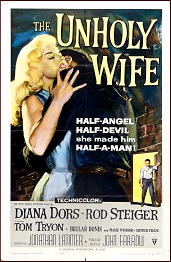
THE UNHOLY WIFE. RKO Radio Pictures, 1957. Diana Dors, Rod Steiger, Tom Tryon, Beulah Bondi, Marie Windsor, Arthur Franz, Joe De Santis. Screenplay: Jonathan Latimer, based on William Durkee’s play “The Prowlers,†telecast on the CBS series Climax! on 05 January 1956. Director: John Farrow.
It’s something of a muddled mess overall, but there is still a lot to like in this end-of-the-era film noir, and noir or not, it needed to be filmed in color, else Diana Dors’ beautifully coiffed mane of brilliant platinum blonde hair would have been as cruelly wasted as a crime against nature itself.
It begins, however, with Dors’ character, Phyllis Hochen, telling the story in what appears to be a dingy room of some type, possibly (and more than likely) a prison cell. Without makeup and with her hair perhaps her natural brown, it gives her a chance to display her acting ability, rather than her other more spectacular attributes. She is barely more than pretty in these scenes, but there’s an honesty about her that one does not notice when she’s playing bombshell, a role which in 1957 she was much well known for, by far.
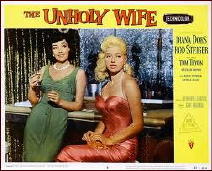
Accompanied by Gwen (Marie Windsor) as a barroom pickup artist, as she tells her story, Phyllis parlayed a small shot into picking up a husband, Paul Hochen (Rod Steiger), a very rich winegrower in northern California. This in spite of the fact that she has a young son and a husband lost in the war. Make that a double: she also warns him that she’s no good.
A warning he ought to have taken. Bored with life in an isolated mansion, it is not long before Phyllis has found a lover, a rodeo cowboy played by the ultra-handsome Tom Tryon. And it is not long after that that Phyllis shoots a prowler by “accident.†The only problem is, the dead man is not her husband, but her husband’s best friend.
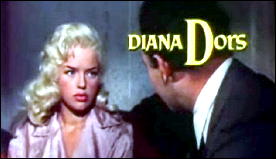
Thinking quickly on her feet, the blonde mane not concealing an empty brain, she convinces her husband to —, then she twists her story around in court so that —, and Paul’s ailing mother overhears —, and then, and then, and then the end.
Can you fill in the blanks? You’re going to have to, because I’m not telling. It’s believable enough, but it would be even more so if the characters weren’t quite so shallow – no, it’s not that they’re shallow. It’s more that we never get to know enough about them, only hints here and there. Some blatant, some hidden. The story shows us their actions. Their motivations are up for grabs.
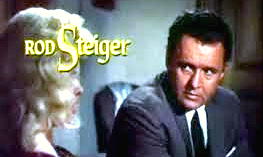
Some reviewers have taken what I took to be a straightforward story and twisted it up and down and inside out and coming up with another story altogether. I won’t tell you anything about that one, either. You’re better off making your own conclusions.
Or in other words, other commentators have been all over the place with this one, including Rod Steiger’s performance, understated in a way that’s not easy to put into words and yet totally dynamic — but as long as you’re asking me, I liked it just fine.
I do wish that Marie Windsor had had a longer part, though. Five minutes with Miss Windsor on the screen is not nearly enough.
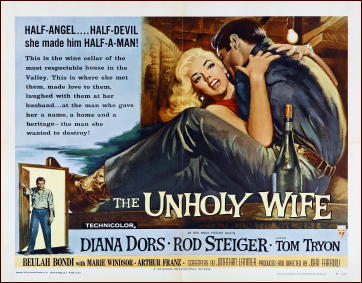
November 19th, 2010 at 2:58 am
That tag line on the poster is half-priceless.
November 19th, 2010 at 8:53 am
This is another example of what makes watching film noir so enjoyable. Even when the film is a muddled mess and you have trouble with the plot and characters, the film noir elements make the film so interesting that the viewer is still satisfied. So many film noirs have multi- layers of meaning and motivation. Unlike many movies, they can be viewed more than once. Even the lesser efforts like this one are so enjoyable and full of great scenes.
One reviewer referred to this as “The Wife From Hell”.
November 19th, 2010 at 4:50 pm
Always struck me as a Hugo Haas movie on steroids.
November 19th, 2010 at 4:54 pm
Now that’s an apt description, in a nutshell. Note that it took me over 500 words to say the same thing — or try to!
September 27th, 2012 at 2:53 pm
Diana Dors – The face & lips of Joey Heatherton & body of Marilyn Monroe…